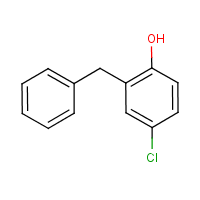Clorophene
Agent Name
Clorophene
Alternative Name
o-Benzyl-p-chlorophenol
CAS Number
120-32-1
Formula
C13-H11-Cl-O
Major Category
Other Classes

Synonyms
o-Benzyl-p-chlorophenol; 2-Benzyl-4-chlorophenol; 4-Chloro-2-(phenylmethyl)phenol; 4-Chloro-2-benzylphenol; 4-Chloro-alpha-phenyl-o-cresol; 4-Chloro-alpha-phenyl-ortho-cresol; 5-Chloro-2-hydroxydiphenylmethane; Benzylchlorophenol; Bio-Clave; Chlorophene; Clorofeno [INN-Spanish]; Clorofenum [INN-Latin]; Clorophene; Ketolin-H; Neosabenyl; Orthobenzyl-p-chlorophenol; Orthobenzylparachlorophenol; Phenol, 4-chloro-2-(phenylmethyl)-; Santophen 1; Santophen 1 flake; Santophen 1 solution; Santophen I; Santophen I germicide; Septiphene; o-Benzylchlorophenol; o-Cresol, 4-chloro-alpha-phenyl-; p-Chloro-o-benzylphenol; [ChemIDplus] UN2020
Category
Halogenated Polyaromatics
Description
White to light tan or pink solid; [Hawley]
Sources/Uses
Used in household, hospital, and veterinary disinfectants; Also used as a fungicide, herbicide, antimicrobial, and cosmetics preservative; [HSDB] Used as a disinfectant (swimming pool decks, industrial water systems, poultry houses and other farming premises, food processing, and restaurants); [Reference #1]
Comments
Emergency medical treatment: see phenol and related agents; A skin irritant; One of the chemicals that can cause toxic vitiligo; [HSDB] Chemical leukoderma is indistinguishable from vitiligo; May occur in workers exposed to hydroquinones, catechols, phenols, or mercaptoamines; [White, p. 285] A mutagen, tumorigen, and mild skin irritant; Causes somnolence and convulsions in lethal-dose studies of mice; [RTECS] A skin, mucous membrane, and respiratory tract irritant; Corrosive to eyes; "It has also caused severe porphyria cutanea tarda." [CAMEO] Chemical associated with acquired porphyria include hexachlorobenzene, 2,4-dichlorophenol, 2,4,5-trichlorophenol, 2,3,7,8-tetrachlorodibenzo-p-dioxin, o-benzyl-p-chlorophenol, 2-benzyl-p-dichlorophenol, vinyl chloride, lead, and aluminum; However, recent studies have failed to find an association between 2,3,7,8-tetrachlorodibenzo-p-dioxin and porphyrin levels; [LaDou, p. 266, 519] Corrosive to eyes; Causes kidney injury in chronic animal experiments and is a possible human carcinogen; [Reference #1] An irritant; Effects in high-dose animal studies include convulsions; [MSDSonline]
Reference Link #1
Biomedical References
Exposure Assessment
Vapor Pressure
5.06E-05 mm Hg
Lethal Concentration
LC (rat) > 13,200 mg/m3
Explanatory Notes
The Guide in the Emergency Response Guidebook is for "Chlorophenols, solid."
Adverse Effects
Neurotoxin
Other CNS neurotoxin
Diseases, Processes, and Activities Linked to This Agent
Processes
Industrial Processes with risk of exposure: